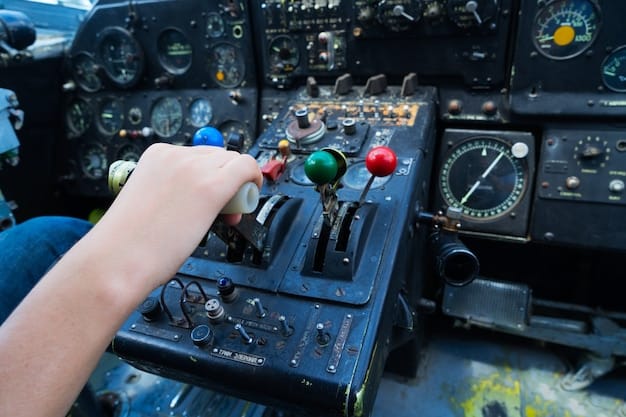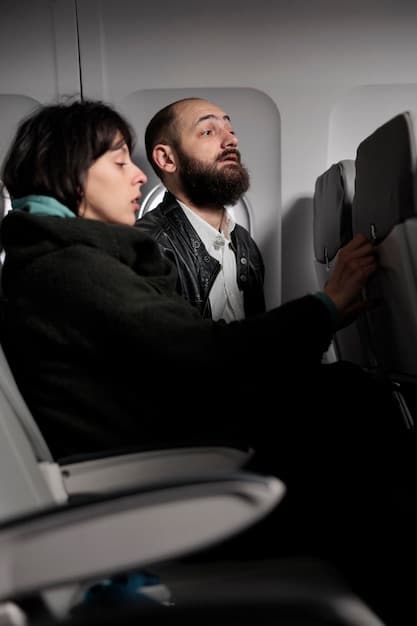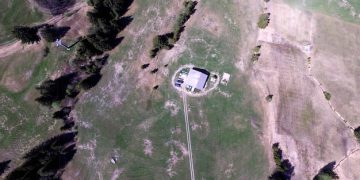Pilot Shortage Crisis: How the US Military is Responding

The US Military is tackling the pilot shortage crisis through increased incentives, improved training programs, and streamlined career paths to attract and retain skilled aviators.
The US military is currently facing a significant pilot shortage, impacting its operational readiness and global reach. This shortage is a complex issue stemming from various factors, including competition from commercial airlines, demanding military lifestyles, and insufficient training capacity. This article examines how the US Military is Addressing the Current Pilot Shortage Crisis, exploring the innovative strategies and initiatives being implemented across different branches to attract, train, and retain skilled aviators.
Understanding the Gravity of the Pilot Shortage
The pilot shortage within the US military is not merely a logistical inconvenience; it poses a serious threat to national security. With fewer pilots available, operational readiness decreases, training schedules are stretched thin, and the ability to respond to global crises is compromised. Addressing this issue requires a multi-faceted approach involving significant investment, policy changes, and a renewed focus on pilot welfare.
Impact on Operational Readiness
A diminished pilot pool directly affects the military’s capacity to execute its missions effectively. Fewer pilots mean fewer flight hours, reduced training opportunities, and a potential degradation in overall skill levels. This can have cascading effects on everything from routine patrols to complex combat operations.
Strain on Existing Pilots
The shortage places immense pressure on the pilots who remain in service. They are often required to work longer hours, take on additional responsibilities, and endure increased deployments. This can lead to burnout, decreased job satisfaction, and ultimately, a higher attrition rate, further exacerbating the shortage.
- Increased workloads and longer deployments affect pilot well-being.
- Burnout leads to decreased job satisfaction and higher attrition rates.
- Reduced training opportunities can degrade overall skill levels.
The consequences of the pilot shortage extend beyond operational concerns. It also impacts the military’s ability to maintain its technological edge, attract top talent, and ensure the long-term sustainability of its aviation programs. Therefore, concerted efforts are essential to mitigate these risks and restore a healthy pilot inventory.
Incentivizing Service: Bonuses, Benefits, and Beyond
One of the primary strategies the US military employs to combat the pilot shortage is offering various incentives to attract and retain pilots. These incentives range from increased bonuses and enhanced benefits packages to improved career advancement opportunities and a greater emphasis on work-life balance. By making military service more appealing, the armed forces aim to compete more effectively with the commercial airline industry.

Enhanced Financial Incentives
Recognizing the allure of lucrative careers in the commercial sector, the military has significantly increased its aviation bonuses. These bonuses can amount to hundreds of thousands of dollars, providing a substantial financial reward for pilots who commit to extended service periods. Additionally, the military offers student loan repayment programs and other financial assistance to ease the burden of higher education costs.
Improved Quality of Life
Beyond monetary compensation, the military is also focusing on improving the overall quality of life for its pilots. This includes initiatives such as flexible deployment schedules, better access to childcare services, and enhanced healthcare benefits. By addressing the personal and family needs of its aviators, the military hopes to create a more supportive and appealing environment.
- Increased aviation bonuses for extended service commitments.
- Student loan repayment programs to alleviate financial burdens.
- Flexible deployment schedules to improve work-life balance.
These incentives are designed to make military aviation a more attractive career choice, not only by providing competitive compensation but also by fostering a sense of community, purpose, and belonging. By investing in its pilots, the military seeks to cultivate a loyal and dedicated workforce that is committed to serving the nation.
Streamlining Training Programs
Another critical aspect of addressing the pilot shortage is optimizing and modernizing the military’s training programs. Traditional pilot training is often lengthy, resource-intensive, and can be a bottleneck in the pipeline. By streamlining processes, incorporating new technologies, and focusing on core competencies, the military aims to produce more qualified pilots in a shorter amount of time.
Integrating Advanced Technologies
The military is increasingly leveraging advanced technologies such as flight simulators, virtual reality training, and data analytics to enhance its pilot training programs. These tools allow for more realistic and immersive training experiences, reduce the reliance on live flight hours, and provide personalized feedback to trainees. By embracing innovation, the military can accelerate the learning process and improve the overall quality of its graduates.
Focusing on Core Skills
To expedite training, the military is also focusing on teaching core skills that are essential for all pilots, regardless of their specific aircraft or mission. This involves standardizing curricula, eliminating redundancies, and emphasizing foundational knowledge such as aerodynamics, navigation, and emergency procedures. By building a strong base of fundamental skills, pilots can transition more easily to different platforms and roles throughout their careers.

- Use of flight simulators and virtual reality for realistic training.
- Data analytics for personalized feedback and performance tracking.
- Standardized curricula focusing on essential piloting skills.
By revamping its training programs, the military aims to not only produce more pilots but also to ensure that they are better prepared for the challenges of modern aviation. This involves fostering critical thinking, problem-solving, and adaptability—qualities that are essential for success in today’s rapidly evolving operational environment.
Targeted Recruitment Strategies
Effective recruitment is vital to ensuring a sufficient influx of new pilots into the military. This requires a strategic approach that identifies potential candidates early, communicates the benefits of military service persuasively, and removes barriers to entry. By tailoring its recruitment efforts to specific demographics and addressing common misconceptions, the military can expand its pool of qualified applicants.
Early Engagement Programs
The military is increasingly engaging with potential pilot candidates at a young age through programs such as Junior ROTC, aviation summer camps, and partnerships with flight schools. These initiatives provide an early introduction to aviation, foster an interest in military service, and offer pathways to pilot training. By investing in outreach programs, the military can cultivate a pipeline of future aviators.
Highlighting Unique Opportunities
Many potential recruits are unaware of the unique opportunities and experiences that military aviation offers. The military is working to better communicate the benefits of flying cutting-edge aircraft, participating in challenging missions, and serving alongside dedicated professionals. By showcasing the rewards of military service, the armed forces can attract individuals who are motivated by purpose, adventure, and the chance to make a difference.
- Junior ROTC and aviation summer camps for early engagement.
- Partnerships with flight schools to offer pilot training pathways.
- Showcasing unique mission opportunities and cutting-edge technology.
Effective recruitment also involves addressing common barriers to entry, such as strict medical requirements, lengthy service commitments, and concerns about deployment risks. By offering waivers, flexible service options, and comprehensive support services, the military can make aviation careers more accessible to a wider range of qualified individuals.
Improving Pilot Retention Rates
While attracting new pilots is essential, retaining experienced aviators is equally important. High attrition rates can negate the benefits of recruitment and training efforts, resulting in a constant cycle of shortages. The military is implementing various measures to improve retention, including enhanced career development opportunities, better deployment policies, and a greater emphasis on work-life balance.
Career Advancement Opportunities
Pilots are more likely to remain in the military if they see clear pathways for career advancement. The military is creating more opportunities for pilots to take on leadership roles, pursue advanced training, and contribute to policy decisions. By investing in their professional growth, the military can foster a sense of ownership and commitment among its aviators.
Family Support Programs
The demands of military service can place a significant strain on pilots and their families. The military is enhancing its family support programs to provide resources such as counseling services, childcare assistance, and spousal employment support. By addressing the needs of military families, the armed forces can create a more supportive environment that encourages pilots to remain in service.
- Leadership roles and advanced training opportunities for career growth.
- Enhanced access to counseling, childcare, and spousal support services.
- Policies that promote a healthy balance between work and personal life.
Effective retention also requires addressing the underlying factors that contribute to pilot burnout and dissatisfaction. This includes reducing excessive workloads, promoting a culture of respect and appreciation, and providing channels for pilots to voice their concerns and suggestions. By creating a positive and supportive work environment, the military can foster loyalty and reduce attrition.
Legislative and Policy Changes
Addressing the pilot shortage also requires legislative and policy changes at the national level. These changes can include increasing funding for pilot training, modifying service requirements, and streamlining the process for transitioning military pilots to civilian careers. By working with Congress and other stakeholders, the military can create a more favorable environment for attracting and retaining aviators.
Increased Funding for Training
Pilot training is expensive, and the military needs adequate funding to maintain its infrastructure, purchase new equipment, and support its instructors. By increasing investment in training, Congress can help the military produce more pilots and ensure that they are equipped with the latest skills and knowledge.
Streamlining Transition to Civilian Careers
Many military pilots eventually transition to civilian careers, often in the commercial airline industry. The military is working to streamline this process by ensuring that pilots receive the certifications and credentials they need to seamlessly transition to civilian jobs. By making it easier for pilots to pursue post-military careers, the armed forces can attract individuals who are seeking long-term opportunities.
- Increased congressional funding for pilot training programs.
- Policies that facilitate the transition to civilian aviation careers.
- Modifications to service requirements to improve flexibility.
Legislative and policy changes can also address broader issues such as healthcare benefits, retirement policies, and access to educational opportunities. By advocating for policies that support military personnel and their families, the military can create a more attractive and sustainable career path for its pilots.
Conclusion
In conclusion, the US military’s response to the pilot shortage crisis is multifaceted, involving enhanced incentives, streamlined training, targeted recruitment, improved retention, and strategic policy changes. By addressing the root causes of the shortage and investing in its aviators, the military aims to ensure that it has the skilled personnel it needs to maintain its operational readiness and meet the challenges of the future. The success of these efforts will depend on continued collaboration between the military, Congress, and the aviation industry.
| Key Point | Brief Description |
|---|---|
| 💰 Enhanced Bonuses | Increasing financial incentives to attract and retain pilots. |
| ✈️ Training Programs | Modernizing training with advanced technologies for efficiency. |
| 🤝 Recruitment | Targeting potential candidates early through outreach programs. |
| 🛡️ Retention | Improving career development and family support for retention. |
FAQ
▼
The primary cause is competition from commercial airlines, which offer high salaries and less demanding lifestyles compared to military service. This makes it challenging to attract and retain skilled pilots.
▼
The military is offering substantial bonuses, sometimes hundreds of thousands of dollars, for pilots who commit to extended service periods. These bonuses aim to make military careers more financially competitive.
▼
Flight simulators, virtual reality training, and data analytics are increasingly used. These technologies provide realistic training experiences, reduce live flight hour reliance, and offer personalized feedback to trainees.
▼
Early engagement programs like Junior ROTC, aviation summer camps, and flight school partnerships are used. These initiatives introduce aviation early, fostering interest in military service for younger individuals.
▼
The military focuses on flexible deployment schedules, better childcare access, and enhanced healthcare benefits. These improvements address personal and family needs, creating a more supportive and appealing environment.
Conclusion
The US military’s comprehensive approach, including incentives, training improvements, strategic recruitment, and policy adjustments, aims to address the pilot shortage. By focusing on these key areas, the military aims to ensure a sufficient number of skilled aviators for maintaining operational readiness.





